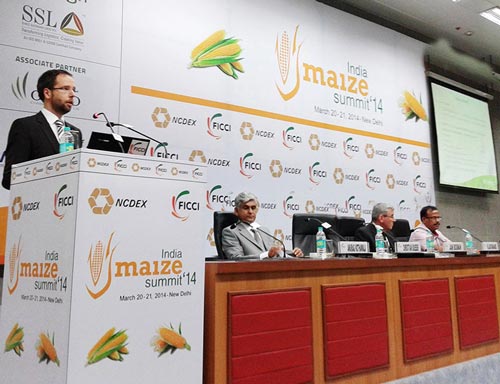By Christian Böeber and Subash S.P./CIMMYT
A recent summit in India provided a platform for various stakeholders along the maize value chain to discuss maize trade, technological gaps, industrial utilization, post-harvest management, risk management, marketing and scaling up of maize value chains through public-private partnerships (PPP).
“Road Map for Sustainable Growth and Developing Value Chain” was the title of the India Maize 2014 Summit held on 20-21 March in New Delhi. The summit was organized by the Federation of Indian Chambers of Commerce and Industry (FICCI) and the National Commodity and Derivatives Exchange (NCDEX). Participants included representatives from private input companies, millers, the poultry industry, the starch industry, service providers, national and international research institutions, policy makers, embassies and farmers from across India. A. Didar Singh, secretary general of FICCI, said there has been a “quiet revolution” happening in Indian agriculture with the emergence of the export market and an evolving private sector, particularly in maize, during the last several years.
The diversification of cropping patterns in Punjab and Haryana to promote maize in these states was reviewed by Ashok Gulati, chair professor for agriculture at the Indian Council for Research on International Economic Relations, during his keynote address. He said the maize sector in India currently depends on the poultry and export sector and is therefore vulnerable if demand from those sectors weakens. He emphasized policy should support quality protein maize (QPM) as an ingredient for poultry feed but also for human consumption. Adel Yusupov, regional director for the U.S. Grain Council in South and Southeast Asia, highlighted Southeast Asia’s prospects for becoming a major importer of maize. India’s advantage in targeting those emerging markets due to its proximity and lower pricing was highlighted by Rajiv Yadav, vice president of the Nobel Group. He noted nonetheless that Indian maize exports are constrained by unreliable production, lack of quality produce, high levels of moisture and aflatoxins, logistics and warehousing facilities.

Maize production and productivity are stagnant because farmers have been slow to adopt new technologies such as hybrids, said Sain Dass, president of the Indian Maize Development Association, adding that the main hurdle in the adoption of hybrids is the lack of seed. Christian Böeber, CIMMYT agricultural and market economist, presented information about CIMMYT’s maize research activities in India, including the Abiotic Stress Tolerant Maize for Asia project (ATMA) and the Heat Stress Tolerant Maize for Asia project (HTMA). He also reflected on the diverse uses of maize and the challenges faced by maize production systems in the country, including the commercial seed supply gap. Success stories in India involving PPPs were discussed.
O.P. Yadav, director of the Directorate of Maize Research of the Indian Council of Agricultural Research, highlighted the need to improve maize productivity in India through PPPs and by working through the proper national channels for seed development and deployment. Shipla Divekar Nirula, director of corporate affairs and strategy for Monsanto, presented her perspective on scaling up maize value chains through PPPs and referred to the Water Efficient Maize for Africa (WEMA) project as an example for successful PPPs in developing and deploying improved maize varieties. She emphasized that for a partnership to be effective, it is important to clearly define the purpose, platforms and principles of working together. A viable platform should include crop diversification, infrastructure provision, knowledge sharing, a viable extension network and growth policies.
 Capacity development
Capacity development 
